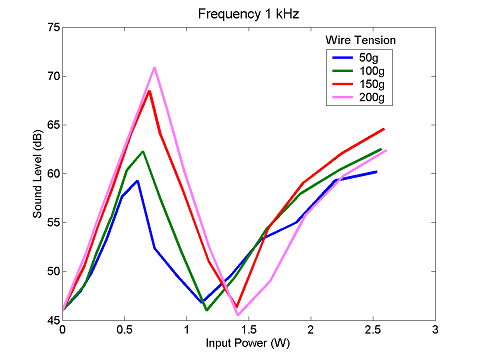In order to investigate if the sound produced by the SMA loudspeaker is caused by the Shape Memory Effect, we performed the following experiment. We applied a heating current signal of the form a(1+sin(ωt)), where a is the signal amplitude and ω is the frequency, which was set to 1 kHz. As a is increased, the average power to the SMA rises from zero to a level that would heat it well beyond the temperature range where the shape memory effect occurs (but not so hot as to damage it). Thus, at the highest input currents, the SMA behaves like an ordinary metal. We used a sound level meter to measure the sound intensity (in decibels) at several values of a, and at several different wire tensions. The results are shown in the graph below. (The loudspeaker is not as loud as the figures in the graph suggest: the meter was placed close to the cup.)

In a normal metal wire, the sound level should increase steadily with increasing input power. This is because a normal metal undergoes thermal expansion and contraction when heated and cooled. The higher the input power, the hotter the wire becomes, leading to a bigger temperature difference between the wire and the surrounding air. This results in a faster cooling rate, hence a larger temperature swing in the wire. So, if the sound were due to normal thermal expansion then the graph would show a steady rise in sound level with increasing input power.
If the sound is produced by the shape memory effect then the sound level should rise with increasing input power until the temperature approaches the upper end of the phase transformation range, and then it should go down. Once the temperature is above the transformation range, the SMA will behave like an ordinary metal, and the sound level should start to go up again. So the sound level should go up, then down, then up again; and that is exactly what we see in the graph. Furthermore, the drop occurs at progressively higher temperatures as we increase the tension on the wire, which agrees with the well-known property of SMA that stress increases the phase transformation temperatures.
These results support the hypothesis that the sound is indeed produced by the shape memory effect.